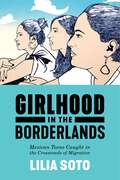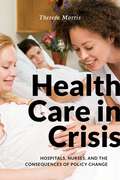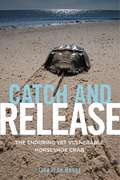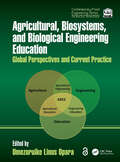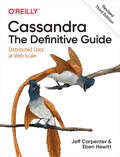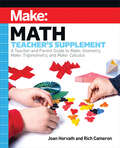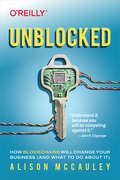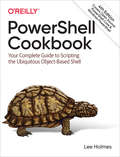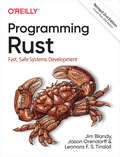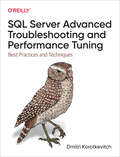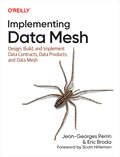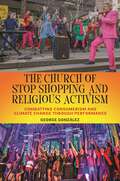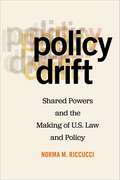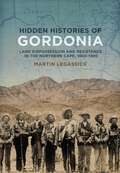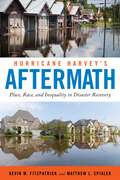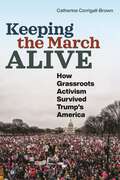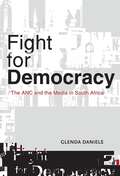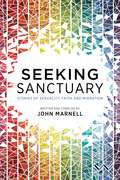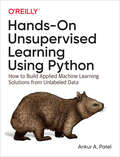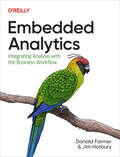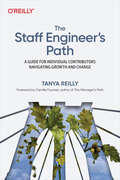- Table View
- List View
Girlhood in the Borderlands: Mexican Teens Caught in the Crossroads of Migration (Nation of Nations #1)
by Lilia SotoHow gender and generation shape perceptions of place and time as told through the voices of Mexican teenage girls This book examines the lived experiences of Mexican teenage girls raised in transnational families and the varied ways they make meaning of their lives. Under the Bracero Program and similar recruitment programs, Mexican men have for decades been recruited for temporary work in the U.S., leaving their families for long periods of time to labor in the fields, factories, and service industry before returning home again. While the conditions for these adults who cross the border for work has been extensively documented, very little attention has been paid to the lives of those left behind. Over a six-year period, Lilia Soto interviewed more than sixty teenage girls in Napa, California and Zinapécuaro, Michoacán to reveal the ruptures and continuities felt for the girls surrounded by the movement of families, ideas, and social practices across borders. As they develop their subjective selves, these Mexican teens find commonality in their fathers’ absence and the historical, structural, and economic conditions that led to their movement. Tied to the ways U.S. immigration policies dictate the migrant experiences of fathers and the traditional structure of their families, many girls develop a sense of time-lag, where they struggle to plan for a present or a future. In Girlhood in the Borderlands, Soto highlights the “structure of feeling” that girls from Zinapécuaro and Napa share, offering insight into the affective consequences of growing up at these social and geographic intersections.
Health Care in Crisis: Hospitals, Nurses, and the Consequences of Policy Change
by Theresa MorrisAn inside look into how hospitals, nurses, and patients are faring under the Affordable Care Act More and more not-for-profit hospitals are becoming financially unstable and being acquired by large hospital systems. The effects range from not having necessary life-saving equipment to losing the most experienced nurses to better jobs at other hospitals. In Health Care in Crisis, Theresa Morris takes an in-depth look at how this unintended consequence of the Affordable Care Act plays out in a non-profit hospital’s obstetrical ward. Based on ethnographic observations of and in-depth interviews with obstetrical nurses and hospital administrators at a community, not-for-profit hospital in New England, Health Care in Crisis examines how nurses’ care of patients changed over the three-year period in which the Affordable Care Act was implemented, state Medicaid funds to hospitals were slashed, and hospitals were being acquired by a for-profit hospital system. Morris explains how the tumultuous political-economic changes have challenged obstetrical nurses, who are at the front lines of providing care for women during labor and birth. In the context of a new environment where hospital reimbursements are tied to performance, nursing has come under much scrutiny as documentation of births—already laboriously high—has reached even greater levels. Providing patient-centered care is an organizational challenge that nurses struggle to master in this context. Some nurses become bogged down by new processes and bureaucratic procedures, while others focus on buffering patients from the effects of these changes with little success. Morris maintains that what is most important in delivering quality care to patients is the amount of interaction time spent with patients, yet finding that time is a real challenge in this new environment. As questions and policies regarding health care are changing rapidly, Health Care in Crisis tells an important story of how these changes affect nurses’ ability to care for their patients.
Catch and Release: The Enduring Yet Vulnerable Horseshoe Crab
by Lisa Jean MooreThe unexpected and fascinating interspecies relationship between humans and horseshoe crabs.Horseshoe crabs are considered both a prehistoric and indicator species. They have not changed in tens of millions of years and provide useful data to scientists who monitor the health of the environment. From the pharmaceutical industry to paleontologists to the fishing industry, the horseshoe crab has made vast, but largely unknown, contributions to human life and our shared ecosystem. Catch and Release examines how these intersections steer the trajectory of both species’ lives, and futures. Based on interviews with conservationists, field biologists, ecologists, and paleontologists over three years of fieldwork on urban beaches, noted ethnographer Lisa Jean Moore shows how humans literally harvest the life out of the horseshoe crabs. We use them as markers for understanding geologic time, collect them for agricultural fertilizer, and eat them as delicacies, capture them as bait, then rescue them for conservation, and categorize them as endangered. The book details the biomedical bleeding of crabs; how they are caught, drained of 40% of their blood, and then released back into their habitat. The model of catch and release is essential. Horseshoe crabs cannot be bred in captivity and can only survive in their own ecosystems. Moore shows how horseshoe crabs are used as an exploitable resource, and are now considered a “vulnerable” species.An investigation of how humans approach animals that are essential for their survival, Catch and Release questions whether humans should have divine, moral, or ethical claims to any living being in their path.
Agricultural, Biosystems, and Biological Engineering Education: Global Perspectives and Current Practice (Contemporary Food Engineering)
by Umezuruike Linus OparaAgricultural engineering, developed as an engineering discipline underpinned by physics, applies scientific principles, knowledge, and technological innovations in the agricultural and food industries. During the last century, there was exponential growth in engineering developments, which has improved human wellbeing and radically changed how humans interact with each other and our planet. Among these, “Agricultural Mechanization” is ranked among the top 10 in a list of 20 Top Engineering Achievements of the last century that have had the greatest impact on the quality of life.While many success stories abound, the problems of low appeal among students, identity crises, and limited job opportunities in many climes continue to trouble the discipline’s future in many parts of the world. Yet agriculture and agricultural engineering remain fundamental to assuring food and nutrition security for a growing global population.Agricultural, Biosystems, and Biological Engineering Education provides the first comprehensive global review and synthesis of different agricultural, biosystems, and biological engineering education approaches, including a detailed exposition of current practices from different regions.Key Features: Describes novel approaches to curriculum design and reform Outlines current and emerging epistemology and pedagogies in ABBE education Provides a framework to grow agricultural engineering in Africa and other developing regions Highlights the role of ABBE education in the context of the SDGs Presented in 3 parts and containing 42 chapters, this book covers the historical evolution of agricultural engineering education and discusses the emergence of biological and biosystems engineering education. It will appeal to engineers and other professionals, education planners and administrators, and policy makers in agriculture and other biological industries.Chapters 4, 11, 19, 32, and 41 of this book are freely available as a downloadable Open Access PDF at http://www.taylorfrancis.com under a Creative Commons Attribution-Non Commercial-No Derivatives (CC-BY-NC-ND) 4.0 license.
Cassandra (Revised) Third Edition: Distributed Data at Web Scale
by Eben Hewitt Jeff CarpenterImagine what you could do if scalability wasn't a problem. With this hands-on guide, you'll learn how the Cassandra database management system handles hundreds of terabytes of data while remaining highly available across multiple data centers. This revised third edition--updated for Cassandra 4.0 and new developments in the Cassandra ecosystem, including deployments in Kubernetes with K8ssandra--provides technical details and practical examples to help you put this database to work in a production environment.Authors Jeff Carpenter and Eben Hewitt demonstrate the advantages of Cassandra's nonrelational design, with special attention to data modeling. Developers, DBAs, and application architects looking to solve a database scaling issue or future-proof an application will learn how to harness Cassandra's speed and flexibility.Understand Cassandra's distributed and decentralized structureUse the Cassandra Query Language (CQL) and cqlsh (the CQL shell)Create a working data model and compare it with an equivalent relational modelDesign and develop applications using client driversExplore cluster topology and learn how nodes exchange dataMaintain a high level of performance in your clusterDeploy Cassandra onsite, in the cloud, or with Docker and KubernetesIntegrate Cassandra with Spark, Kafka, Elasticsearch, Solr, and Lucene
Make: Math Teacher's Supplement
by Joan Horvath Rich CameronMake: Math Teacher's Supplement is the essential guide for teachers, parents, and other educators wanting to supplement their curriculum with Joan Horvath and Rich Cameron's Make: Geometry, Make: Trigonometry, and Make: Calculus books.This book is a companion to the three math books, and does not duplicate the content in them. Drawing on the authors' experience guiding both students and teachers, it covers:The philosophy behind the Make: math book series, including the key inclusion of universal design principles to make the material accessible to those who learn differently A list of topics, projects, and needed maker skills, tied to the math book chapters Key learning objectives and associated assessment ideas A practical primer on 3D printing in an educational environment Helpful tips to manage student 3D printed workflow Five specific examples of ways to use content from the math books, including studying geometry with castles and using LEGO bricks to demonstrate calculus conceptsPacked with tips and links to online resources, Make: Math Teacher's Supplement will let you see how to build math intuition to create a solid base for your learner's future.
Cost-Effective Data Pipelines: Balancing Trade-Offs When Developing Pipelines in the Cloud
by Sev LeonardThe low cost of getting started with cloud services can easily evolve into a significant expense down the road. That's challenging for teams developing data pipelines, particularly when rapid changes in technology and workload require a constant cycle of redesign. How do you deliver scalable, highly available products while keeping costs in check?With this practical guide, author Sev Leonard provides a holistic approach to designing scalable data pipelines in the cloud. Intermediate data engineers, software developers, and architects will learn how to navigate cost/performance trade-offs and how to choose and configure compute and storage. You'll also pick up best practices for code development, testing, and monitoring.By focusing on the entire design process, you'll be able to deliver cost-effective, high-quality products. This book helps you:Reduce cloud spend with lower cost cloud service offerings and smart design strategiesMinimize waste without sacrificing performance by rightsizing compute resourcesDrive pipeline evolution, head off performance issues, and quickly debug with effective monitoringSet up development and test environments that minimize cloud service dependenciesCreate data pipeline code bases that are testable and extensible, fostering rapid development and evolutionImprove data quality and pipeline operation through validation and testing
Unblocked: How Blockchains Will Change Your Business (and What to Do About It)
by Alison McCauleyUnderstand the Blockchain Opportunity: No Technical Background Required. Remember thedawn of the internet? The advent of mobile and social media? Yet another digital revolution is nowunderway. Like its predecessors, blockchains are about to transform the way we live, work, and play,while disrupting entrenched industries and shattering conventional business models.Move past the hype and equip yourself to forecast how blockchains will change our world and impactyou and your business. Author Alison McCauley helps non-technical executives to understandhow this technology will trigger change, shift the balance of power, and bring competitiveadvantage to those who know how to leverage them.Unblocked explains:Why ignoring this technology exposes you to competitive disruptionWhat this new technology revolution embraces—no technical background requiredHow to prepare your organization to respond to the coming shift
Qiskit Pocket Guide: Quantum Development with Qiskit
by James L. Weaver Frank J. HarkinsThe quantum computing market is predicted to grow by nearly $1.3 billion over the next five years. Why? Given their quantum mechanical nature, quantum computers are expected to solve difficult problems in chemistry, optimization, finance, and machine learning that classical computers find impossible to unravel.This pocket guide provides software developers with a quick reference to Qiskit, an open source SDK for working with quantum computers. Packed with helpful programming examples, tables, figures, and lists, this handy book helps you find the information you need to develop and debug quantum programs.Whether you're focused on business, engineering, or scientific applications, you'll learn how to choose and apply appropriate Qiskit classes, methods, and functions.Learn how to create quantum circuits, define quantum gates, and leverage the transpilerExplore modules for implementing quantum information concepts and quantum algorithmsSurvey features of Qiskit that abstract and facilitate working with various quantum computers and simulatorsLearn how to use the latest version of the Open Quantum Assembly Language
PowerShell Cookbook: The Complete Guide To Scripting Microsoft's Command Shell
by Lee HolmesHow do you use PowerShell to navigate the filesystem, manage files and folders, or retrieve a web page? This introduction to the PowerShell language and scripting environment provides more than 400 task-oriented recipes to help you solve all kinds of problems. Intermediate to advanced system administrators will find more than 100 tried-and-tested scripts they can copy and use immediately.Updated for PowerShell 5.1 and Open Source PowerShell up to 7.0 and beyond, this comprehensive cookbook includes hands-on recipes for common tasks and administrative jobs that you can apply whether you're on the client or server version of Windows. You also get quick references to technologies used in conjunction with PowerShell, including regular expressions, the XPath language, format specifiers, and frequently referenced .NET, COM, and WMI classes.Learn how to use PowerShell on Windows 10 and Windows Server 2019Tour PowerShell's core features, including the command model, object-based pipeline, and ubiquitous scriptingMaster fundamentals such as the interactive shell, pipeline, and object conceptsPerform common tasks that involve working with files, internet-connected scripts, user interaction, and moreSolve tasks in systems and enterprise management, such as working with Active Directory and the filesystem
Programming Rust
by Jim Blandy Jason Orendorff Leonora F. S. TindallSystems programming provides the foundation for the world's computation. Writing performance-sensitive code requires a programming language that puts programmers in control of how memory, processor time, and other system resources are used. The Rust systems programming language combines that control with a modern type system that catches broad classes of common mistakes, from memory management errors to data races between threads.With this practical guide, experienced systems programmers will learn how to successfully bridge the gap between performance and safety using Rust. Jim Blandy, Jason Orendorff, and Leonora Tindall demonstrate how Rust's features put programmers in control over memory consumption and processor use by combining predictable performance with memory safety and trustworthy concurrency.You'll learn:Rust's fundamental data types and the core concepts of ownership and borrowingHow to write flexible, efficient code with traits and genericsHow to write fast, multithreaded code without data racesRust's key power tools: closures, iterators, and asynchronous programmingCollections, strings and text, input and output, macros, unsafe code, and foreign function interfacesThis revised, updated edition covers the Rust 2021 Edition.
Learning Data Science: Data Wrangling, Exploration, Visualization, and Modeling with Python
by Deborah Nolan Sam Lau Joseph GonzalezAs an aspiring data scientist, you appreciate why organizations rely on data for important decisions--whether it's for companies designing websites, cities deciding how to improve services, or scientists discovering how to stop the spread of disease. And you want the skills required to distill a messy pile of data into actionable insights. We call this the data science lifecycle: the process of collecting, wrangling, analyzing, and drawing conclusions from data.Learning Data Science is the first book to cover foundational skills in both programming and statistics that encompass this entire lifecycle. It's aimed at those who wish to become data scientists or who already work with data scientists, and at data analysts who wish to cross the "technical/nontechnical" divide. If you have a basic knowledge of Python programming, you'll learn how to work with data using industry-standard tools like pandas.Refine a question of interest to one that can be studied with dataPursue data collection that may involve text processing, web scraping, etc.Glean valuable insights about data through data cleaning, exploration, and visualizationLearn how to use modeling to describe the dataGeneralize findings beyond the data
SQL Server Advanced Troubleshooting and Performance Tuning: Best Practices and Techniques
by Dmitri KorotkevitchThis practical book provides a comprehensive overview of troubleshooting and performance tuning best practices for Microsoft SQL Server. Database engineers, including database developers and administrators, will learn how to identify performance issues, troubleshoot the system in a holistic fashion, and properly prioritize tuning efforts to attain the best system performance possible.Author Dmitri Korotkevitch, Microsoft Data Platform MVP and Microsoft Certified Master (MCM), explains the interdependencies between SQL Server database components. You'll learn how to quickly diagnose your system and discover the root cause of any issue. Techniques in this book are compatible with all versions of SQL Server and cover both on-premises and cloud-based SQL Server installations.Discover how performance issues present themselves in SQL ServerLearn about SQL Server diagnostic tools, methods, and technologiesPerform health checks on SQL Server installationsLearn the dependencies between SQL Server componentsTune SQL Server to improve performance and reduce bottlenecksDetect poorly optimized queries and inefficiencies in query execution plansFind inefficient indexes and common database design issuesUse these techniques with Microsoft Azure SQL databases, Azure SQL Managed Instances, and Amazon RDS for SQL Server
Implementing Data Mesh: Design, Build, and Implement Data Contracts, Data Products, and Data Mesh
by Jean-Georges Perrin Eric BrodaAs data continues to grow and become more complex, organizations seek innovative solutions to manage their data effectively. Data mesh is one solution that provides a new approach to managing data in complex organizations. This practical guide offers step-by-step guidance on how to implement data mesh in your organization.In this book, Jean-Georges Perrin and Eric Broda focus on the key components of data mesh and provide practical advice supported by code. Data engineers, architects, and analysts will explore a simple and intuitive process for identifying key data mesh components and data products. You'll learn a consistent set of interfaces and access methods that make data products easy to consume.This approach ensures that your data products are easily accessible and the data mesh ecosystem is easy to navigate. This book helps you:Identify, define, and build data products that interoperate within an enterprise data meshBuild a data mesh fabric that binds data products togetherBuild and deploy data products in a data meshEstablish the organizational structure to operate data products, data platforms, and data fabricLearn an innovative architecture that brings data products and data fabric together into the data meshAbout the authors:Jean-Georges "JG" Perrin is a technology leader focusing on building innovative and modern data platforms.Eric Broda is a technology executive, practitioner, and founder of a boutique consulting firm that helps global enterprises realize value from data.
The Church of Stop Shopping and Religious Activism: Combatting Consumerism and Climate Change through Performance (North American Religions)
by George GonzálezExplores the religious activism of the Stop Shopping Church performance groupSince the dawn of the new millennium, the grassroots performance activist group the Stop Shopping Church has advanced a sophisticated anti-capitalist critique in what they call “Earth Justice.” Led by co-founders, Reverend Billy and Savitri D, the Church of Stop Shopping have sung with Joan Baez and toured with Pussy Riot and Neil Young. They performed at festivals around the world, and been the subject of the nationally released documentary, What Would Jesus Buy? They opposed the forces of consumerism on the global stage, and taken on the corporate practices of Disney, Starbucks, J.P. Morgan Chase Bank, Walmart, Amazon, and many others. While the Church maintains an anti-consumerism stance at its core–through performances, street actions, and social activism–the community also prioritizes work for racial justice, queer liberation, justice and sanctuary for immigrants, First Amendment issues, the reclaiming of public space, and in an increasingly central way, environmental justice. In The Church of Stop Shopping and Religious Activism, George González draws on interviews, participant observation, and digital ethnography to offer insight into the Church, its make up, its activities, and in particular, how it has shifted over time from parody to a deep and serious engagement with religion. Reverend Billy and the Church of Stop Shopping maintain that corporations and their celebrity spokespeople operate in much the same way churches do. González uses the group’s performance activism to showcase the links between religion, the culture of capitalist consumerism, and climate catastrophe and to analyze the ways in which consumers are ritualized into accepting capitalism and its consequences. He argues that the members and organizers of the Church of Stop Shopping are serious theorizers and users of religion in their own right, and that they offer keen insights into our understanding of ritualistic consumerism and its indelible link to the rising sea levels that threaten to engulf us all.
Policy Drift: Shared Powers and the Making of U.S. Law and Policy
by Norma M. RiccucciThe role of formal and informal institutional forces in changing three areas of U.S. public policy: privacy rights, civil rights and climate policyThere is no finality to the public policy process. Although it’s often assumed that once a law is enacted it is implemented faithfully, even policies believed to be stable can change or drift in unexpected directions. The Fourth Amendment, for example, guarantees Americans’ privacy rights, but the 9/11 terrorist attacks set off one of the worst cases of government-sponsored espionage. Policy changes instituted by the National Security Agency led to widespread warrantless surveillance, a drift in public policy that led to lawsuits challenging the constitutionality of wiretapping the American people. Much of the research in recent decades ignores the impact of large-scale, slow-moving, secular forces in political, social, and economic environments on public policy. In Policy Drift, Norma Riccucci sheds light on how institutional forces collectively contributed to major change in three key areas of U.S. policy (privacy rights, civil rights, and climate policy) without any new policy explicitly being written. Formal levers of change—U.S. Supreme Court decisions; inaction by Congress; Presidential executive orders—stimulated by social, political or economic forces, organized permutations which ultimately shaped and defined contemporary public policy.Invariably, implementations of new policies are embedded within a political landscape. Political actors, motivated by social and economic factors, may explicitly employ strategies to shift the direction of existing public polices or derail them altogether. Some segments of the population will benefit from this process, while others will not; thus, “policy drifts” carry significant consequences for social and economic change. A comprehensive account of inadvertent changes to privacy rights, civil rights, and climate policy, Policy Drift demonstrates how unanticipated levers of change can modify the status quo in public policy.
Hidden Histories of Gordonia: Land dispossession and resistance in the Northern Cape, 1800–1990
by Martin LegassickThe Gordonia region of the Northern Cape province has received relatively little attention from historians. In Hidden Histories of Gordonia: Land dispossession and resistance in the Northern Cape, 1800–1990, Martin Legassick explores aspects of the generally unknown ‘brown’ and ‘black’ history of the region. Emphasising the lives of ordinary people, his writing is also in part an exercise in ‘applied history’ – historical writing with a direct application to people’s lives in the present.Tracing the indigenous history of Gordonia as well as the northward movement of Basters and whites from the western Cape through Bushmanland to the Orange River, the book presents accounts of family histories, episodes of indigenous resistance to colonisation, and studies of the ultimate imposition of racial segregation and land dispossession on the inhabitants of the region. A recurrent theme is the question of identity and how the extreme ethnic fluidity and social mixing apparent in earlier times crystallised in the colonial period into racial identities, until with final conquest came imposed racial classification.
Hurricane Harvey's Aftermath: Place, Race, and Inequality in Disaster Recovery
by Kevin M. Fitzpatrick Matthew L. SpialekHeartbreaking stories from survivors along the Texas Gulf CoastHurricane Harvey was one of the worst American natural disasters in recorded history. It ravaged the Texas Gulf Coast, and left thousands of people homeless in its wake. In Hurricane Harvey’s Aftermath, Kevin M. Fitzpatrick and Matthew L. Spialek offer first-hand accounts from survivors themselves, providing a rare, on-the-ground perspective of natural disaster recovery. Drawing on interviews from more than 350 survivors, the authors trace the experiences of individuals and their communities, both rich and poor, urban and rural, white, Latinx, and Black, and how they navigated the long and difficult road to recovery after Hurricane Harvey. From Corpus Christi to Galveston, they paint a vivid, compelling picture of heartache and destruction, as well as resilience and recovery, as survivors slowly begin rebuilding their lives and their communities. An emotionally provocative read, Hurricane Harvey’s Aftermath provides insight into how ordinary people experience and persevere through a disaster in an age of environmental vulnerability.
Keeping the March Alive: How Grassroots Activism Survived Trump's America
by Catherine Corrigall-BrownHow activist groups across the country adapted their strategies and tactics to their local contexts to keep the protests aliveOn January 21, 2017, the day after Trump's inauguration, feminist activists and allies across many progressive movements assembled across the United States to express their displeasure with the new President and his agenda. These marches were unprecedented in size, bringing together as many as 5.3 million Americans, with at least 408 protests in cities and towns across the country. These protests were large and dramatic, and had an outsized impact. But, they do not tell the whole story of this wave of contention.Keeping the March Alive follows thirty-five progressive groups founded after the Women’s March across ten cities from Amarillo and Atlanta to Pasadena and Pittsburgh to tell the whole story of how some social movement organizations survive and thrive while others falter. Catherine Corrigall-Brown explains how activists navigate their local context and make strategic decisions about tactics, coalitions, individual participation, and online technologies to keep their movements alive. Movements that had the most success in keeping members engaged and active were those that were able to adjust their strategies to their particular local contexts. While in larger and more liberal cities, engaging in expressly political coalitions and cooperating only with other social movement organizations was the most successful strategy, fostering broad coalitions among churches, charities, and businesses was most successful in smaller, more conservative cities. Keeping the March Alive is instrumental in understanding how activism and activist groups can be sustained over time and how larger protest movements can last.
Fight for Democracy: The ANC and the media in South Africa
by Glenda DanielsFight for Democracy is a penetrating and critical scrutiny of the ANC’s treatment of the print media since the inception of democracy in 1994. In this book, Glenda Daniels does not hide behind a veil of detachment, but instead makes a passionate argument for the view that newspapers and journalists play a significant role in the deepening of democratic principles.Glenda Daniels examines the pattern of paranoia that has crept into public discourse about the media and the ANC, and their conflictual relationship. She analyses this fraught relationship through various popular media stories, such as Manto and Mondli, Zapiro and Zuma. Her argument is that there is some hysteria on the part of the ruling party and its allies, for instance the SACP, regarding the media’s exposés, which partially rests on the problem of conflating party, state and ‘the people’. Daniels presents her argument against the backdrop of the impending clamp down on media freedom, the twin threats of the Protection of State Information Bill (Secrecy Bill) and the media appeals tribunal, both of which, she asserts, signify closures in South Africa’s democracy. The book challenges the view held by the ANC that journalists are anti-transformation and that they take instruction from the owners of the media houses; that they are ‘capitalist bastards’ and ‘enemies of the people’.
Seeking Sanctuary: Stories of Sexuality, Faith and Migration
by John MarnellA glimpse into the lives of LGBTQ migrants in Johannesburg, in their own words Seeking Sanctuary brings together poignant life stories from fourteen lesbian, gay, bisexual and transgender (LGBT) migrants, refugees and asylum seekers living in Johannesburg, South Africa. The stories, diverse in scope, chronicle each narrator’s arduous journey to South Africa, and their corresponding movement towards self-love and self-acceptance. The narrators reveal their personal battles to reconcile their faith with their sexuality and gender identity, often in the face of violent persecution, and how they have carved out spaces of hope and belonging in their new home country. In these intimate testimonies, the narrators’ resilience in the midst of uncertain futures reveal the myriad ways in which LGBT Africans push back against unjust and unequal systems.Seeking Sanctuary makes a critical intervention by showing the complex interplay between homophobia and xenophobia in South Africa, and of the state of sexual orientation and gender identity (SOGI) rights in Africa. By shedding light on the fraught connections between sexuality, faith and migration, this ground-breaking project also provides a model for religious communities who are working towards justice, diversity and inclusion.
Healing the Exposed Being: The Ngoma healing tradition in South Africa
by Robert ThorntonThis ethnography explores the Ngoma healing tradition as practiced in eastern Mpumalanga, South Africa. ‘Bungoma’ is an active philosophical system and healing practice consisting of multiple strands, based on the notion that humans are intrinsically exposed to each other and that this is the cause of illness, but also the condition for the possibility of healing. This healing seeks to protect the ‘exposed being’ from harm through augmenting the self. Unlike Western medicine, it does not seek to cure physical ailments but aims to prevent suffering by allowing patients to transform their personal narratives of Self. Like Western medicine, it is empirical and is presented as a ‘local knowledge’ that amounts to a practical anthropology of human conflict and the environment. The book seeks to bring this anthropology and its therapeutic applications into relation with global academic anthropology by explaining it through political, economic, interpretive, and environmental lenses
Hands-On Unsupervised Learning Using Python: How to Build Applied Machine Learning Solutions from Unlabeled Data
by Ankur A. PatelMany industry experts consider unsupervised learning the next frontier in artificial intelligence, one that may hold the key to general artificial intelligence. Since the majority of the world's data is unlabeled, conventional supervised learning cannot be applied. Unsupervised learning, on the other hand, can be applied to unlabeled datasets to discover meaningful patterns buried deep in the data, patterns that may be near impossible for humans to uncover.Author Ankur Patel shows you how to apply unsupervised learning using two simple, production-ready Python frameworks: Scikit-learn and TensorFlow using Keras. With code and hands-on examples, data scientists will identify difficult-to-find patterns in data and gain deeper business insight, detect anomalies, perform automatic feature engineering and selection, and generate synthetic datasets. All you need is programming and some machine learning experience to get started.Compare the strengths and weaknesses of the different machine learning approaches: supervised, unsupervised, and reinforcement learningSet up and manage machine learning projects end-to-endBuild an anomaly detection system to catch credit card fraudClusters users into distinct and homogeneous groupsPerform semisupervised learningDevelop movie recommender systems using restricted Boltzmann machinesGenerate synthetic images using generative adversarial networks
Embedded Analytics: Integrating Analysis with the Business Workflow
by Donald Farmer Jim HorburyOver the past 10 years, data analytics and data visualization have become essential components of an enterprise information strategy. And yet, the adoption of data analytics has remained remarkably static, reaching no more than 30% of potential users. This book explores the most important techniques for taking that adoption further: embedding analytics into the workflow of our everyday operations.Authors Donald Farmer and Jim Horbury show business users how to improve decision making without becoming analytics specialists. You'll explore different techniques for exchanging data, insights, and events between analytics platforms and hosting applications. You'll also examine issues including data governance and regulatory compliance and learn best practices for deploying and managing embedded analytics at scale.Learn how data analytics improves business decision making and performanceExplore advantages and disadvantages of different embedded analytics platformsDevelop a strategy for embedded analytics in an organization or productDefine the architecture of an embedded solutionSelect vendors, platforms, and tools to implement your architecture Hire or train developers and architects to build the embedded solutions you needUnderstand how embedded analytics interacts with traditional analytics
The Staff Engineer's Path: A Guide for Individual Contributors Navigating Growth and Change
by Tanya ReillyFor years, companies have rewarded their most effective engineers with management positions. But treating management as the default path for an engineer with leadership ability doesn't serve the industry well--or the engineer. The staff engineer's path allows engineers to contribute at a high level as role models, driving big projects, determining technical strategy, and raising everyone's skills.This in-depth book shows you how to understand your role, manage your time, master strategic thinking, and set the standard for technical work. You'll read about how to be a leader without direct authority, how to plan ahead to make the right technical decisions, and how to make everyone around you better, while still growing as an expert in your domain.By exploring the three pillars of a staff engineer's job, Tanya Reilly, a veteran of the staff engineer track, shows you how to:Take a broad, strategic view when thinking about your workDive into practical tactics for making projects succeedDetermine what "good engineering" means in your organization
